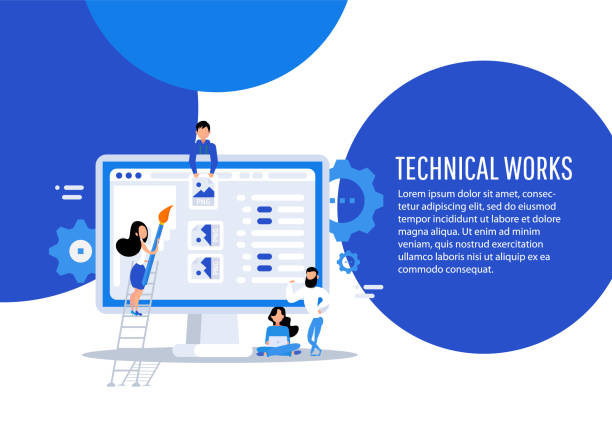Chapter One: What is Responsive Web Design and Why is it Crucial?

In today’s world, where digital devices are diversifying at an astonishing rate, having a static, one-dimensional website no longer meets user needs.
#Today’s users access the web with devices such as smartphones, tablets, laptops, and even smart TVs.
Responsive Web Design is the answer to this challenge.
This approach means building a website that can automatically adjust its layout and content to the size of the user’s device screen.
This feature not only improves the user experience but also helps your website rank better in search engines like Google.
The importance of responsive web design goes beyond being just an option; it is a strategic necessity for any business that wants to have an effective online presence.
A website’s inability to adapt to different devices can lead to traffic loss, reduced conversion rates, and ultimately, damage to your brand.
This is an educational and explanatory approach to understanding the foundation of this vital technology.
This type of design allows webmasters to provide an optimal user experience on any device with a single codebase, which significantly reduces development and maintenance costs.
#Optimization for #different_devices and ensuring content accessibility on any platform is the main goal of this method.
A precise understanding of the principles behind this concept is the first step for its successful implementation.
Are you dissatisfied with the low visitor-to-customer conversion rate on your e-commerce site?
Solve this problem forever with professional e-commerce website design by Rasaweb!
✅ Increase visitor-to-customer conversion rate
✅ Create an excellent user experience and build customer trust
⚡ Get free consultation
Chapter Two: Countless Benefits of Responsive Design for SEO and User Experience

One of the most important reasons businesses are moving towards responsive web design is its significant benefits for SEO.
Google has explicitly stated that it prefers responsive websites and gives them a higher ranking in search results.
This means that a website with a responsive design has a greater chance of being seen in mobile searches, which constitute a large portion of web traffic.
In addition to SEO, user experience (UX) significantly improves.
When a user accesses your website via mobile and encounters an optimized version that does not require zooming or horizontal scrolling, their satisfaction increases.
This improvement in UX means a reduction in Bounce Rate, an increase in user time on site, and ultimately, an increase in conversion rates.
This section provides a deep analytical insight into the positive impacts of responsive web design, showing how investing in this area can yield significant returns.
Not needing to manage multiple versions of a website (such as a separate desktop and mobile version) also reduces maintenance and development costs.
#SEO_improvement and #user_experience are among the most important achievements of this approach.
An adaptive website means easier access for all users, anytime, anywhere.
Chapter Three: Technical Principles and Implementation Techniques of Responsive Design

The implementation of responsive web design is based on three key principles: Media Queries, Fluid Grids, and Flexible Images.
Media Queries are the backbone of this approach; they enable CSS rules to be applied based on device characteristics such as screen width, height, orientation, and resolution.
For example, we can define different styles for a small smartphone screen and a large desktop monitor.
Fluid Grids use relative units like percentages, instead of fixed pixel units, to flexibly divide page space.
This allows elements to automatically adjust their size as the screen width changes.
Flexible Images, using the `max-width: 100%;` property, ensure that images never overflow their containers and resize correctly.
This section is a completely technical and practical guide for developers who want to learn the technical details of responsive web design.
The following table presents the most common Breakpoints for Media Queries, which are very useful in the responsive design process.
#Media_Query #Fluid_Grids #Flexible_Images These three principles together ensure the full adaptability of the website.
| Type of Device | Screen Width (pixels) | Application Example |
|---|---|---|
| Smartphones (small) | Up to 375px | Adjusting fonts and buttons for fingers |
| Smartphones (standard) | 376px – 767px | Single-column design for better readability |
| Tablets | 768px – 991px | Using a hamburger menu or collapsible menu |
| Laptops/Desktops (small) | 992px – 1199px | Displaying 2 or 3 columns of content |
| Desktops (large) | 1200px and above | Full design with open menu and all features |
Chapter Four: Modern Tools and Frameworks for Responsive Design

To facilitate and speed up the process of responsive web design, numerous tools and frameworks have been developed.
Bootstrap is probably the most well-known CSS framework, offering a comprehensive set of ready-made components and a responsive grid system.
Using Bootstrap can significantly reduce development time and ensure that the website displays correctly on various devices.
In addition to Bootstrap, native CSS technologies like CSS Grid and Flexbox have revolutionized how responsive layouts are designed.
Flexbox is very powerful for one-dimensional layouts (rows or columns), and Grid for two-dimensional layouts (both rows and columns), providing more precise control over how elements are displayed at different screen sizes.
These tools enable the implementation of responsive web design approaches more efficiently.
This section is a practical and expert guide for selecting and using the best tools for responsive web design projects.
#Bootstrap #Flexbox #CSS_Grid Each of these tools has unique features that can be utilized according to project needs.
Choosing the right tools and frameworks is crucial for the success of a responsive web design project and can make a big difference in development speed and quality.
Is your e-commerce site ready to attract maximum customers and increase sales? Rasaweb transforms your online business with modern and efficient e-commerce website designs.
✅ Increased speed and improved SEO
✅ Excellent user experience on mobile and desktop⚡ Get free e-commerce website design consultation from Rasaweb!
Chapter Five: Common Challenges and Pitfalls in Responsive Web Design

Despite its many benefits, responsive web design is not without its challenges.
One of the biggest pitfalls is performance issues.
If not properly optimized, a responsive website can be slow on mobile devices, especially if large images and heavy JavaScript resources are used.
This is because the website must load all resources for every screen size, even if they are not needed.
Another challenge is managing complex content and unconventional layouts.
Converting a complex desktop design into a simple and readable mobile layout requires careful planning and creativity.
Additionally, ensuring that all interactive elements (such as forms and buttons) work correctly on different screen sizes requires extensive testing and debugging.
This section of the article provides thought-provoking and analytical content that helps developers anticipate and prevent these issues.
#Challenges #Performance #Design_Complexity Failure to address these challenges can lead to a poor user experience and ultimately, the failure of a responsive web design project.
Image optimization, Lazy Loading, and using Mobile-First techniques are important solutions to overcome these problems.
Successful adaptive websites have carefully identified these challenges and found appropriate solutions for them.
Chapter Six: New Trends and the Future of Responsive Web Design

The world of the web is constantly evolving, and responsive web design is no exception.
New trends are emerging that shape the future of this field.
One of the most important of these trends is Progressive Web Applications (PWAs), which provide a user experience close to native applications through the web browser.
PWAs, with capabilities such as offline functionality, notifications, and installation on the home screen, blur the line between website and application, and their optimization for mobile devices is of high importance.
Another trend is increased attention to Dark Mode and accessibility settings, which push responsive web design towards more personalization and inclusivity.
The use of “Component-Based Design” techniques also helps developers design different parts of the website independently and reusably, which simplifies the responsive development process.
This is a news and analytical section that examines the latest innovations in the field of adaptive web design.
#New_Trends #PWA #Future_of_Web These developments show that responsive web design is not just a technique, but a growing philosophy that seeks to provide the best possible user experience in any environment.
Chapter Seven: Testing and Debugging Responsive Websites

After implementing responsive web design, the critical stage of testing and debugging begins.
Ensuring that the website works correctly on all devices and screen sizes requires a comprehensive approach.
Using browser developer tools (such as Chrome DevTools) is essential for simulating different screen sizes and devices.
These tools allow for quick testing and viewing of changes, but they can never replace testing on real devices.
Testing on physical devices (various phones, tablets, and desktops) is very important to ensure touch accuracy, sensor performance, and a real user experience.
Additionally, using online responsive testing tools and cloud testing services (such as BrowserStack or LambdaTest) can help cover a wide range of devices and browsers.
This section is a specialized and in-depth guide on how to ensure the final quality of responsive web design.
The following table lists common testing tools for responsive websites.
#Website_Testing #Debugging #Testing_Tools Regular and precise testing is the key to successfully delivering a flawless and adaptive website.
| Tool Name | Type | Key Features |
|---|---|---|
| Chrome DevTools | In-browser | Device simulation, screen resizing, element inspection |
| BrowserStack | Cloud Platform | Testing on hundreds of real devices and browsers, live debugging |
| LambdaTest | Cloud Platform | Automated and manual testing, integration with CI/CD tools |
| Responsinator | Online Tool | Simultaneous display of website in multiple common sizes |
| Am I Responsive? | Online Tool | Displaying website on an image of multiple devices (mobile, tablet, laptop) |
Chapter Eight: Successful Examples of Responsive Web Design

Examining successful examples of responsive web design can be inspiring and guiding.
Many major brands and high-traffic websites have been using this approach for years and have achieved brilliant results.
For example, news websites like New York Times or BBC News are fully responsive and provide an excellent reading experience on any device, from small phones to smart TVs.
These websites, with fluid layouts, optimized images, and readable fonts at various sizes, clearly demonstrate how rich content can be delivered adaptably.
E-commerce platforms like Amazon are also prime examples of responsive web design that allow users to buy and browse products seamlessly on any device.
These successes are the result of precise investment and planning in responsive web design.
This section of the article is entertaining and educational, providing the reader with a practical view of this design’s application through real-world examples.
#Successful_Examples #Major_Brands #Inspiration Observing these examples confirms the power and importance of responsive web design in the real world and shows how this approach can help businesses succeed.
Do you know that your website is customers’ first impression of your company? Multiply your business’s credibility with a powerful corporate website from Rasaweb!
✅ Custom and eye-catching design tailored to your brand
✅ Improved user experience and increased customer attraction
⚡ Get a free consultation!
Chapter Nine: Measuring Success and Data Analysis in Responsive Websites

After implementing and launching a website with responsive web design, the next stage is measuring success and analyzing data.
Web analytics tools like Google Analytics allow you to monitor your website’s performance across different devices.
You can compare bounce rate, time on site, pages visited, and conversion rates based on device type (desktop, mobile, tablet).
These analyses help you identify the strengths and weaknesses of your responsive design and implement necessary improvements.
For example, if the bounce rate on mobile is high, further optimization for these devices might be needed.
Paying attention to mobile page loading speed metrics through tools like Google PageSpeed Insights is also crucial, as speed is a key factor in user experience and SEO on mobile devices.
This section provides an analytical and explanatory approach for a deeper understanding of the impact of responsive web design on business performance.
#Data_Analysis #Metrics #User_Behavior By using this data, we can make more informed decisions to continuously improve our adaptive website and ensure we provide the best experience to users on any platform.
Chapter Ten: Conclusion – The Future of the Web is in the Hands of Responsive Web Design

Ultimately, it can be said that responsive web design is no longer a luxury option, but a necessity for any website that wants to succeed in today’s digital space.
Given the ever-increasing use of mobile devices and platform diversity, an adaptive website allows you to reach a wider audience, provide a better user experience, and improve your search engine rankings.
This approach means investing in the future of the web and ensuring the sustainability of your online presence.
Its benefits, from improved SEO and reduced maintenance costs to increased customer satisfaction and conversion rates, are countless.
As we saw in previous chapters, by understanding technical principles, using appropriate tools, and paying attention to future challenges and trends, a powerful website with responsive web design can be implemented.
This is a summary and explanatory approach that emphasizes the ultimate importance of this technology.
#Digital_Future #Responsive_Importance #Summary Embracing responsive web design is a significant step towards building a more global, accessible, and efficient web.
The website you design today must be ready for tomorrow’s devices.
This philosophy forms the core of modern web development and guides us in creating unparalleled digital experiences.
Frequently Asked Questions
| Question | Answer |
|---|---|
| What is responsive web design? | It is a web design approach aimed at creating websites that can automatically adapt to the screen size and device of the user (computer, tablet, mobile) and provide the best user experience. |
| Why is responsive design important? | Its importance has increased due to the growing diversity of devices people use to access the internet. This design improves user experience, increases search engine rankings (SEO), and reduces maintenance costs. |
| How is responsive design implemented? | By using CSS techniques such as Media Queries that allow you to change styles based on device characteristics (like screen width), Fluid Grids, and Flexible Images. |
| What are the key principles of responsive design? | The three main principles are: Fluid Grids (using relative units like percentages instead of pixels for widths), Flexible Images (adapting image sizes to available space), and Media Queries (applying different styles based on screen characteristics). |
| What are the benefits of having a responsive website? | Providing a unified user experience across all devices, improved SEO, increased user time on site, reduced bounce rate, easier site management and updates (only one codebase). |
And other services of Rasa Web Advertising Agency in the field of advertising:
Smart Sales Automation: A professional solution for digital branding focusing on intelligent data analysis.
Smart Social Media: A new service to enhance customer behavior analysis through intelligent data analysis.
Smart UI/UX: An effective tool for digital branding by optimizing key pages.
Smart UI/UX: A combination of creativity and technology to increase click-through rates by precisely targeting the audience.
Smart Data Analysis: A combination of creativity and technology for online growth by utilizing real data.
And over hundreds of other services in the field of internet advertising, advertising consultation, and organizational solutions.
Internet Advertising | Advertising Strategy | Advertorial
Sources
What is Responsive Design?
Benefits of Responsive Web Design
How to Implement Responsive Design
Responsive Design Tools
? To elevate your business in the digital world, Rasaweb Afarin Digital Marketing Agency, specializing in secure website design and SEO, offers innovative and effective solutions.
📍 Tehran, Mirdamad Street, next to Bank Markazi, Southern Kazeroon Alley, Ramin Alley, No. 6



